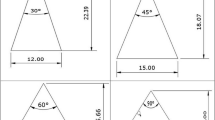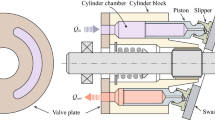Abstract
This study was conducted using a rotating non-axisymmetric cavitator to artificially increase the size of the cavity. Computational analysis was performed to predict the size of the cavity with a cavitation number of 0.3. To analyze the effect of the shape of the cavitator, six cavitator shapes were used by combining the cavitator thickness, the angle of the blades, the angle between the side surface of the blade and the rotating direction. The results of the study showed that the length of the cavity increased as the rotation velocity increased during the rotation of the cavitator. The drag force increased as the rotation velocity increased, but the increase was small. As a result, the length of the cavity for the same drag increased significantly as the side surface of the cavitator was perpendicular to the direction of rotation and the thickness of the cavitator was thick. The length of the cavity against the same drag was larger than that of a conventional disk cavitator.
Similar content being viewed by others
Abbreviations
- A cross :
-
Cross-section area of cavity [m2]
- d :
-
Maximum cavity diameter [m]
- d rep :
-
Representative value of maximum cavity diameter [m]
- d 0 :
-
Outer diameter of cavitator [m]
- \(\vec F\) :
-
Body force [N]
- F cond :
-
Condensation coefficient
- F vap :
-
Evaporation coefficient
- g :
-
Acceleration of gravity [m/s2]
- i :
-
Number of phases
- J :
-
Advance ratio
- K T :
-
Thrust coefficient
- K Q :
-
Torque coefficient
- L :
-
Maximum cavity length [m]
- L c :
-
Characteristic length [m]
- n :
-
Number of bubbles
- p :
-
Pressure [Pa]
- p a :
-
Ambient static pressure [Pa]
- p v :
-
Vapor pressure [Pa]
- R :
-
Term of mass transfer rate
- R c :
-
Condensate term of net mass transfer rate
- R e :
-
Evaporation term of net mass transfer rate
- R B :
-
Bubble radius [m]
- Re :
-
Reynolds number
- T :
-
Thickness of cavitator [m]
- U :
-
Freestream velocity [m/s]
- \({{\vec v}_{dr}}\) :
-
Drift velocity [m/s]
- \({{\vec v}_m}\) :
-
Mass averaged velocity [m/s]
- α :
-
Volume fraction
- θ :
-
Angle of cavitator blade [degree]
- λ :
-
Tip speed ratio
- μ :
-
Viscosity [Pa·s]
- μ m :
-
Viscosity of mixture [Pa·s]
- ρ :
-
Density [kg/m3]
- ρ l :
-
Density of liquid [kg/m3]
- ρ m :
-
Density of mixture [kg/m3]
- ρ v :
-
Density of vapor [kg/m3]
- σ :
-
Cavitation number
- τ :
-
The stress tensor
- ω :
-
Rotation velocity [rad/s]
References
X. Cheng, Z. Chang and Y. Jiang, Study on the influence of the specific area of balance hole on cavitation performance of high- speed centrifugal pump, Journal of Mechanical Science and Technology, 34 (2020) 3325–3334.
S. Hong, Y. Wu, J. Wu, Y. Zhang, Y. Zheng, J. Li and J. Lin, Microstructure and cavitation erosion behavior of HVOF sprayed ceramic-metal composite coatings for application in hydro-turbines, Renewable Energy, 164 (2021) 1089–1099.
H. J. Hwang, J. Park and J. K. Min, A numerical study on the flow control characteristic of a cavitating venturi with one- and two-stage diffusers, Journal of Mechanical Science and Technology, 35 (2021) 1463–1472.
Z. Y. Zheng, L. Wang, W. H. Cai, X. Zheng, Q. Li, T. Kunugi, H. Li and F. C. Li, Spatiotemporal evolution of rotational natural cavitation in rotational supercavitating evaporator for desalination, Journal of Fluids Engineering, 142(5) (2020) 051205.
J. P. Franc and J. M. Michel, Fundamentals of Cavitation, Kluwer Academic Publishers, Dordrecht (2004).
S. Ashley, Warp drive underwater, Scientific American, 284(5) (2001) 70–79.
T. Kiceniuk, An Experimental Study of the Hydrodynamic Forces Acting on a Family of Cavity-Producing Conical Bodies of Revolution Inclined to the Flow, CIT Hydrodynamics Report E-12.17, California Institute of Technology (1954).
C. Brennen, A numerical solution of axisymmetric cavity flows, Journal of Fluid Mechanics, 37(4) (1969) 671–688.
M. P. Tulin, On the shape and dimensions of three-dimensional cavities in supercavitating flows, Applied Scientific Research, 58 (1998) 51–61.
A. Karn, R. E. A. Arndt and J. Hong, An experimental investigation into supercavity closure mechanisms, Journal of Fluid Mechanics, 789 (2016) 259–284.
X. Yuan and T. Xing, Hydrodynamic characteristics of a supercavitating vehicle’s aft body, Ocean Engineering, 114 (2016) 37–46.
M. R. Erfanian and M. Anbarsooz, Numerical investigation of body and hole effects on the cavitation glow behind a disk cavitator at extremely low cavitation numbers, Applied Mathematical Modelling, 62 (2018) 163–180.
A. Sikirica, Z. Carija, L. Kranjcevic and I. Lucin, Grid type and turbulence model influence on propeller characteristics prediction, Journal of Marine Science and Engineering, 7(10) (2019) 374.
O. Usta and E. Korkut, A study for cavitating flow analysis using DES model, Ocean Engineering, 160 (2018) 397–411.
J. W. Lindau, R. F. Kunz, D. A. Boger, D. R. Stinebring and H. J. Gibeling, High reynolds number, unsteady, multiphase CFD modeling of cavitating flows, Journal of Fluids Engineering, 124(3) (2002) 607–616.
B. K. Ahn, K. S. Kim, S. W. Jeong and H. G. Yoon, An experimental study on multi-injected artificial supercavitation, Journal of the Society of Naval Architects of Korea, 58(1) (2021) 24–31.
M. P. Kinzel, J. W. Lindau and R. F. Kunz, Gas entrainment from gaseous supercavities: insight based on numerical simulation, Ocean Engineering, 221(1) (2021) 108544.
H. An, P. Sun, H. Ren and Z. Hu, CFD-based numerical study on the ventilated supercavitating flow of the surface vehicle, Ocean Engineering, 214(15) (2020) 107726.
F. R. Menter, Two-equation eddy-viscosity turbulence models for engineering applications, AIAA Journal, 32(8) (1994) 1598–1605.
G. H. Schnerr and J. Sauer, Physical and numerical modeling of unsteady cavitation dynamics, 4th International Conference on Multiphase Flow, New Orleans (2001).
H. Rouse and J. S. McNown, Cavitation and Pressure Distribution: Head Forms at Zero Angle of Yaw, State University of Iowa Studies in Engineering Series 32, State University of Iowa, Iowa City (1948).
F. M. Owis and A. H. Nayfeh, Numerical simulation of 3-D incompressible, multi-phase flows over cavitating projectiles, European Journal of Mechanics B/Fluids, 23 (2004) 339–351.
D. H. Kim, W. G. Park and C. M. Jung, Numerical simulation of cavitating flow past axisymmetric body, International Journal of Naval Architecture and Ocean Engineering, 4 (2012) 256–266.
H. J. Heinke, Potsdam Propeller Test Case (PPTC), Cavitation Tests with the Model Propeller VP1304, Report 3753, Schiffbau-Versuchsanstalt Potsdam, Potsdam, GmBH (2011).
Acknowledgements
This research was partially supported by CLEW Inc. (http://clew.tech). We thank our colleagues from CLEW Inc. who provided insight and expertise that greatly assisted the research.
Author information
Authors and Affiliations
Corresponding author
Additional information
Seongmin Kim is a Ph.D. student in Mechanical Engineering at Hanyang University in Seoul, Korea. Currently, he is a Member in the Applied Aerodynamics Laboratory and is majoring in Aerodynamics. He has studied aerodynamic analyses of fan, aircraft and multiphase flow.
Jinsoo Cho is a Professor of Mechanical Engineering at Hanyang University in Seoul, Korea. He is in charge of the Applied Aerodynamics Laboratory. In 1988, he received his Ph.D. from Purdue University, USA. His doctoral research topic was steady/unsteady aerodynamics analysis for the aircraft, the propeller, and the ducted fans. He studies the aerodynamics and turbomachinery.
Rights and permissions
About this article
Cite this article
Kim, S., Lee, J., Lee, H. et al. Effect of rotating, non-axisymmetric cavitator on supercavity size. J Mech Sci Technol 36, 3437–3447 (2022). https://doi.org/10.1007/s12206-022-0622-8
Received:
Revised:
Accepted:
Published:
Issue Date:
DOI: https://doi.org/10.1007/s12206-022-0622-8




